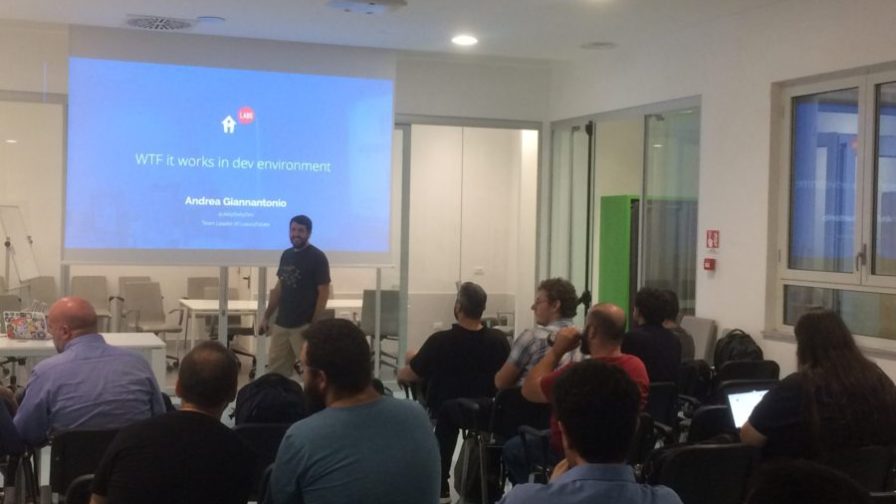
Hello Andrea, you’ve been a fan of Codemotion for a long time but could you tell us a little bit about yourself?
My name is Andrea Giannantonio, I work for the Immobiliare.it group. To be more specific, I manage a technical team of five people who, together with other teams, work at LuxuryEstate, a product focused mainly on luxury homes, upmarket properties, luxury villas, castles, etc. on an international scale (the product is translated into 16 languages!). As for the communities, I have been attending RomaJS meetups since the very beginning (already for five years), as well as PUG Roma meetups. At RomaJS meetups we deal with JavaScript, while PUG Roma it’s all about PHP, which are two programming languages I work with. I also like them most because they let me follow the web scene. I have been a member of PUG Roma for a few years: it was the first meetup I attended, about eight years ago.
In my free time, I keep myself constantly updated with JavaScript and PHP frameworks. Apart from that, fortunately, my work allows me to follow other passions of mine. I like going to rap concerts, watching TV series and food.
You told us that your work and your passion have coincided and that staying up-to-date isn’t a burden for you because it’s part of your passion. How do you keep yourself up-to-date? Is there any method that you prefer? Do you follow webinars, online courses? Do you read books?
Actually, I do everything! I try to be engaged with multiple sources. In our communities, we use social media (Twitter and Slack) to share materials and experience. Within the company, we do the same thing. We have been trying to create a community for almost two years, through tools similar to Slack, to discuss not only about tech evolution but also about us. We engage with one another, we exchange links, videos, books about topics of our interest.
Actually, there are different ways for learning more. Sometimes you can buy a book, other times you can attend the talks at the conferences, or you can learn from videos or blog articles related to the chosen topic. One source of information for developers that is getting very popular right now is Medium, where you can often find really interesting materials.
Why did you choose your job?
I got my degree in IT and one of my last exams was related to database. In order to pass this exam, I carried out a small technical project. On that occasion, I used both the PHP language and JavaScript framework to create a website that dealt with music by aggregating artists and their album covers. A trivial thing to think about now, but this happened more or less 10 years ago and that project was a real flash of inspiration from the business point of view. I’ve always had a passion for computers, but before this moment I had no clear ideas about what I would like to work on. Thanks to this exam and also thanks to the university internship I did for a company that worked on web projects, I fell in love with web development, and everything began there.
Do you think that in the near future you’ll want to change your role or change your job, or maybe you’ll prefer to continue working on your current project?
I consider myself very lucky because I work in a booming company and I’m growing with my company as well, so I don’t imagine my future away from it.
What did you speak about during your last talk? Would you like to share it with us?
The main aim of the talk was to let other colleagues know more about a really great tool, Sentry.io, which is a system of live error reporting. After adding it to your web product, server side and client side, at the precise moment when an anomaly occurs, the tool is able to intercept it and immediately it reports it via an issue on a dedicated web product. It provides visualisation of the entire stack trace in order to reproduce the problem, solve it immediately and get the fix produced straight away. The goal is, therefore, to avoid relying on user reports and to enable us to discover problems promptly, solve them and prevent other users from having the same problems. It’s a tool I discovered some years ago and I presented it to RomaJS meetup members because I find it very effective for client-side languages like JavaScript. I’ll deliver the same talk during PUG Roma meetup because it’s also very effective on the server side. In the company, it helped us in many different contexts to detect particular situations that were difficult to understand, even if we’d received a verbal or email notification.
You’ve told us why this technology is useful and effective. Are there any disadvantages?
On the client side, there is certainly a downside regarding page loading because we’re adding a dependency to the web project, a nice bundle that affects it a bit in terms of performance. But I think it’s a minimal downside taking into consideration all the advantages. As for the server-side languages, there is no such problem. There could just be an impact on costs if you decide not to implement it at home but decide to rely on the web service, which has some usage costs so it doesn’t require maintenance but incurs an extra expense per month.
Who in particular can use this tool?
Developers, obviously. Those who implement features, who deal with them and who have to debug and fix them.
Do you think this tool will continue to evolve in the future, or is it already a perfect tool?
It’s been on the market for about eight or nine years and I consider it a very effective and reliable tool. The thing that fascinates me is that they’re continuing to improve it and they’re continuing to add features that help developers understand the problems better and to group them and direct them to the right person in the team. What’s more, the integration with other tools such as Slack and Asana that allows you to group these issues and send them automatically on their own channels. These integrations allow us to use it easily in our company‘s workflows.
Leaving the technical side, why did you decide to speak about this topic?
I had made a presentation within my company about it. Every Friday, we also organise weekly meetings in order to share what’s been discovered freely. I prepared a presentation about this product on one of that occasion and it was obvious for me to bring it to the communities that I’m a member of. That’s the way it should be: you receive so much from the community, but you must give something back to the community as well. It’s normal to roll up your sleeves and prepare a speech to share with others the information about something that you find useful and can also be useful to others.
In the future, do you think you’ll be able to give other talks on similar topics, or even on this tool, in a slightly more evolved form?
I’ve already done other talks in the past and I’ll certainly do some more in the future. I can’t tell you now if I’ll prepare another one on this topic. It depends on how the tool evolves, and whether I have something more to say about it.
Let’s end with some advice for your colleagues and those who want to follow your career path.
What can I advise others? I can certainly tell you not to stay at home, go to meetups, meet people, talk with your colleagues about your problems and also about the ones you’ve solved, because the problem you solved today can be the problem your colleague will encounter tomorrow. Bring your problems, go and discover others, build a community because it’s something very important and then take all this back to your company. If everything we have learned or want to learn isn’t appreciated, then change the company. Make sure you keep yourself updated and you keep studying. If you can’t manage to do it at work because of time reasons, use your free time.
The world is changing fast and it’s hard to stay updated. Communities can help you in this matter, through the monthly meetings, you can get updated even on a small topic and then you can study it in-depth on your own or with your team. If I had to choose one message I would like to share with the others I would say don’t give up and don’t stop learning and developing your skills.




